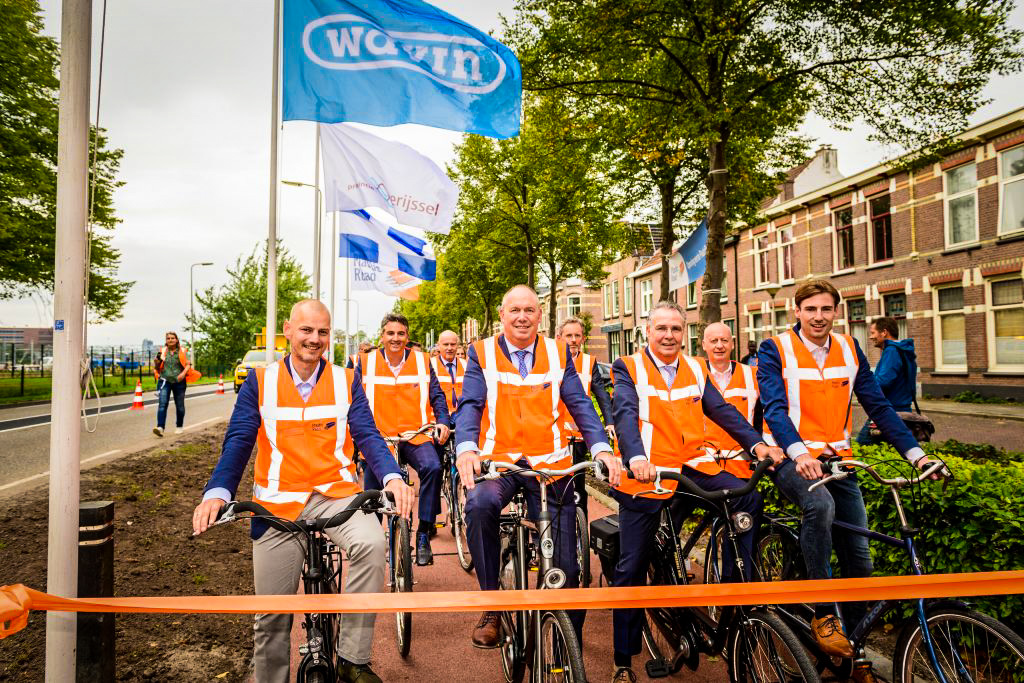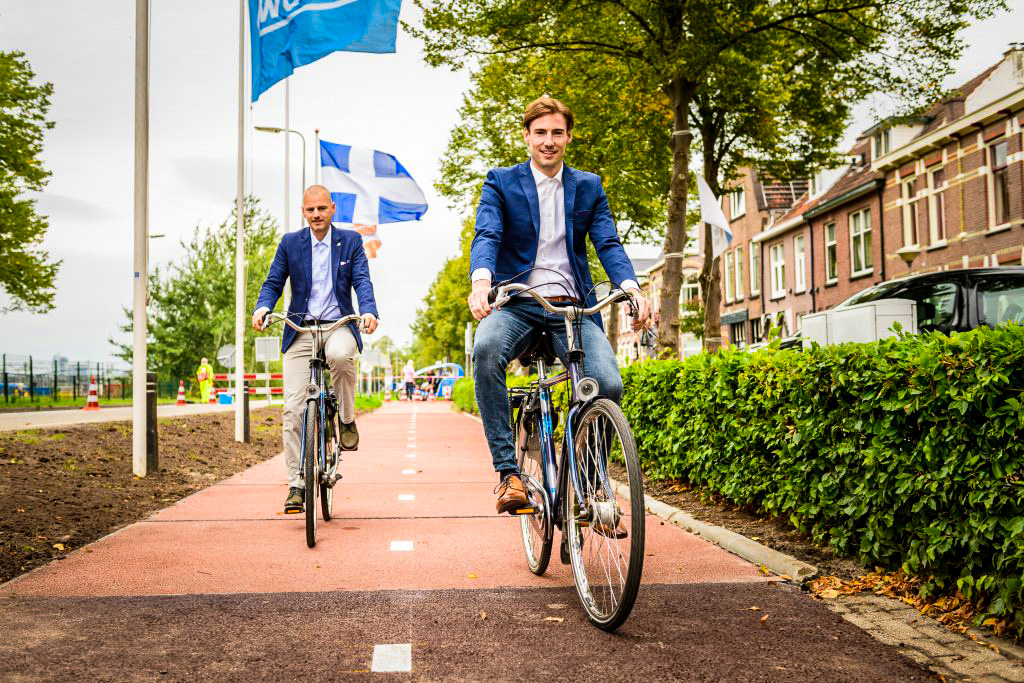How can you solve plastic pollution and flooded cities at the same time? CityChanger Anne Koudstaal and Simon Jorritsma have an answer for you: PlasticRoads. For them, the future generation of road infrastructure consists of recycled plastic.
About 91% of plastic worldwide is not recycled, which has led to massive plastic pollution on our planet – about 8 million tons of plastic end up in the ocean each year. And with megacities such as New York City at risk of floods due to rising sea levels and sinking ground, a solution to both of these issues is urgent.
Together with his colleague Simon Jorritsma, Anne Koudstaal has created something that might do just that: reduce flooding and plastic waste with roads consisting of recycled plastic. What started out as a simple concept on a spreadsheet is now the name of their company: PlasticRoad. We sat down with Anne to hear more about his vision, the implementation process of PlasticRoads, and how other cities could jump aboard.
What is a Plastic Road?
The idea to use recycled plastic for road construction is not new. Paving the roads with plastic is an idea adapted on nearly every continent: Since the early 2000s, India has been experimenting with creating roads out of tons of plastic. Taking it a step further, India’s government made it mandatory in 2015 to use plastic waste at road constructions near large cities.
In Accra, the capital of Ghana, some roads consist of shredded and melted plastic bottles. In 2018, President Akufo-Addo ambitiously announced that by 2030, he plans to recycle as much plastic waste as the country produces each year (1.1 million tons).
In the Netherlands, Anne decided to spice up the concept and kill two birds with one stone: His variation of a plastic road is not only consisting of recycled plastic but is also built in a way that reduces flooding. It consists of circular elements made from recycled plastic with a hollow space inside. Anne explains that the hollow space “can store water and infiltrate it into the ground – it’s a sewer system as well.” PlasticRoads are climate adaptive. The hollow space inside, storing up to 300 litres per square metre, allows water to drain into the soil under the road surface, so aridity during dry spells and flooding can be avoided. Additionally, plastic roads have a much smaller carbon footprint than asphalt roads.
The implementation of PlasticRoads resembles building Legos. A road consists of several detachable and lightweight connections that are quick and simple to install and easily replaceable. For a more visual presentation of what elements PlasticRoads consist of, check out this video. To get details on how the water drainage works, see the video above.
From the Idea to the Product
With a professional background in water management, the problem of urban flooding, which many regions (especially in the Netherlands) are facing, was no news to Anne:
“In the Netherlands, the ground is sinking faster than the water level is rising.”
To tackle urban flooding, innovation is long overdue. In 2013, Anne and Simon sat down and started talking about how future roads could play a part in solving this problem. At this point, the primary goal was to reduce flooding, and Anne and Simon were not set on a material yet. But testing proved plastic to be most effective, and so they solved two problems at once.
Having the concept and the material, the two started a feasibility study, began looking for partners, and were met with enthusiasm. The municipality of Rotterdam supported their idea, saying that “if you can do that, we want it.” This partly unexpected type of eagerness was commonly shared amongst potential partners after a press release in the news. “From that point, we got so much attention and reactions, it was unreal, actually. Even the Guardian was writing about it,” Anne explains smilingly.

Having several stakeholders and partners on board, the team with Marcel Jager as lead engineer started developing prototypes in 2016. One year later, PlasticRoad was tested in an internal pilot trial in Utrecht, with overall positive reactions. The first PlasticRoads were installed in 2018 – two bike lanes of 30 metres that are still in perfect shape nearly three years later.
A Red Thread Through Every Career Step
We looked at the product; let’s look at the man behind it. No matter the job, sustainability has always been a red thread in Anne’s life – so much so that he dedicated his studies to it: His bachelor thesis focused on climate adaption strategies and finding a solution for water problems in urban areas. “From the beginning of my career, I’ve been working on innovative solutions for sustainability. That was always something that gave me energy and motivation.”
Following his passion for sustainability, Anne saw the effects of extreme rainfalls in his own country and how traditional storage systems are unable to handle them. It’s a problem most regions have to deal with going forward. Sinking soils might not be an issue for every city, “but the big cities that are situated in delta areas like Mexico City, Jakarta, New York, they all don’t have the greatest soils.” Recognising this specific problem, Anne committed his work to finding a solution.
When asked about the biggest challenge during the implementation process of PlasticRoad, Anne refers to the initial scepticism of the people when the idea was only on a spread sheet. As this idea was new, friction was inevitable. However, overcoming this challenge is pretty simple: “Of course, you have to accept good feedback. But if the given feedback isn’t really valid, if you can prove it’s possible, then you have to go for it. Prove them wrong.”
As soon as the prototype of PlasticRoad was developed, and the results were indisputably positive, people started getting on board. The best compliment they got from cyclists was that they didn’t notice any difference to a traditional road – you can’t argue against something when there is no actual, visual, and physical distinction.
Advice for CityChangers
Anne has one more advice to give: “If you really want to change something in your city, please look at the problems that you are faced with, like circularity, climate, extreme weather and combine those. Have a holistic approach and don’t go for the easy and traditional way, because that won’t solve the problems we are facing in the future.”
The Future of Road Infrastructure
PlasticRoad is just one of many examples of the promising future of road design. A lot of ideas are already a reality. Many countries have tested out several types of solar energy roads, for example. A solar bike path of 70 metres is able to generate 70 kilowatt-hours per square metre – that is enough to power three houses!
Not only do those roads generate energy, but they also heat up the path up to prevent road slippery in winter. Energy roads will probably even be able to charge up electric vehicles on the go.
And do you remember the glow-in-the-dark stars you had in your childhood room? Well, the Dutch designer Daan Roosegaarde, as well as the company dutch company Smits Neuchatel, use this photoluminising technology in several projects to light up roads and bike paths as an alternative to expensive road lighting. Check out Daan’s projects Smart Highway, Van Gogh Path and Gates of light to get inspired!



Photoluminising products and environments isn’t new.
Companies in the UK have been applying this commercially on parks and drives for more than a decade.
The market hasn’t really taken off in the Public sector because it is often an expensive process, which only the very wealthy in the Private sector can afford.
Question for Anne Koudstaal: This looks like a great initiative, but have you monitored (or are you studying) the water quality of the drainage water? How do you gauge the risk of having microplastics or nano-plastics run-off in the environment over time, now that we know that they then stay a long time in microorganisms and the food chain?
Great ideas or charter to embed potentially harmful materials into our fragile ecosystems?
Let’s see the science behind this to be sure, just because we can doesn’t always mean we should.